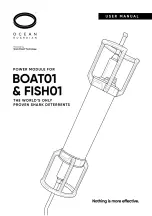
49
The JOULE Thermalstore is designed to provide mains pressure domestic water
water, regardless of whether the heating system is installed as a sealed system or as
an open vent system. As there is a small volume of domestic water within the coil,
the domestic water can be pressurised even when there is an uncontrolled heat
source connected to the cylinder. Domestic water connections should be installed
as per G3 regulations.
The JOULE Thermalstore 1.0 should be maintained at temperature of 70°C to
provide DHW temperature of 60°C leaving the coil. When installing a JOULE Ther-
malstore 1.0, a thermostatic mixing valve should be installed. Its function is to act
as an anti scald protection. The thermostatic mixer is to be set to a temperature of
between 30°C and 60°C and is supplied by in the unvented kit.
The Joule Thermalstore 1.0 is capable of delivering up to 22L/min at a pressure of
2 bar mains pressure. Calculations of water demand should be made based on this
fl ow rate as in applications where there is a larger continuous demand for hot water
the Thermalstore may not have suffi
cient fl ow capacity to meet the demand.
Refer to the table on the previous page for details on setting fl owrates on the
Thermalstore 2.0.
HARD WATER
If the Joule Thermalstore is to be installed in areas with hard water and where there
is a prevalence of limescale, JOULE reccomend installing the Thermalstore 2.0. This
comes with an external heat exchanger built into the Freshwater Module, allowing
for easy replacement in the event of excessive limescale buildup.
It is also recommended to install an inline scale reducer to prolong the lifespan of
DHW coil in the Thermalstore 1.0 or the heat exchanger in the Thermalstore 2.0.
HEATING SYSTEM DESIGN
The 10 N0. 1” tappings on the body of the JOULE Thermalstore are used for heating
system integration. The lowest tappings should be used for return pipework tot he
heating system and heat sources with the highest tappings used for the primary
fl ows from th heat generators. To maximimse DHW volume, use the middle tap-
pings in the Thermalstore for secondary fl ow to the heating zones. This ensures that
DHW is prioritised over the space heating and that the space heating demand will
not reduce the DHW capacity.
Installation
Summary of Contents for Thermalstore 1.0
Page 1: ...1 Thermalstore 1 0 2 0 Installation Manual...
Page 16: ...Thermalstore 16 Thermalstore 1 0 No Solar...
Page 18: ...Thermalstore 18 Thermalstore 1 0 Solar...
Page 20: ...Thermalstore 20 Thermalstore 2 0 No Solar...
Page 22: ...Thermalstore 22 Thermalstore 2 0 Solar...
Page 25: ...25 Electrical Diagram...
Page 27: ...27 Electrical Diagram...
Page 29: ...29 Electrical Diagram...
Page 30: ...Thermalstore 30 Thermalstore Sealed Boiler 2 Radiator Zones Solar Mechanical Diagram...
Page 31: ...31 Electrical Diagram...
Page 32: ...Thermalstore 32 Thermalstore Open Vent Boiler 1 Radiator Zones Mechanical Diagram...
Page 33: ...33 Electrical Diagram...
Page 34: ...Thermalstore 34 Thermalstore Open Vent Boiler 2 Radiator Zones Mechanical Diagram...
Page 35: ...35 Electrical Diagram...
Page 36: ...Thermalstore 36 Thermalstore Solid Fuel Boiler 2 Radiator Zones Mechanical Diagram...
Page 37: ...37 Electrical Diagram...
Page 38: ...Thermalstore 38 Thermalstore Solid Fuel Boiler 2 Radiator Zones Mechanical Diagram...
Page 39: ...39 Electrical Diagram...
Page 41: ...41 Electrical Diagram Electrical Diagram...
Page 43: ...43 Electrical Diagram...
Page 45: ...45 Electrical Diagram...
Page 47: ...47 Electrical Diagram...
Page 64: ...Thermalstore 64 Mains Pressure Hot...
Page 65: ...65 Water Storage System Commisioning Checklist...
Page 66: ...Thermalstore 66...
Page 67: ...67 Service Record...
















































